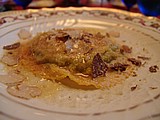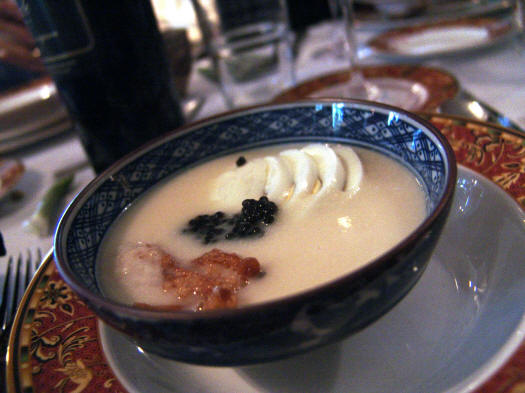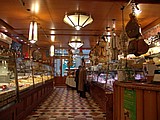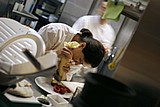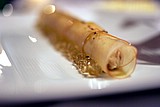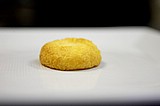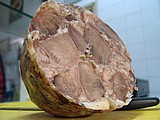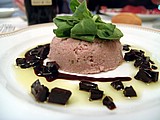Home |
Restaurants by City
|
Food Photography |
Archive | Philosophy |
![]()
Right now we are eating in Seattle, Washington.
|
Thursday
2005
Permalink
|
San Domenico, Imola, Italy, tasted on March 23, 2004 — There is simply no doubt that Italy is a superior country when it comes to food. And the beauty is that the quality is expressed at every level of the food "chain". But to be honest, our experience at the high end wasn't superlative, until that is, we arrived in Imola to eat at San Domenico. With two Michelin stars we weren't exactly finding a hidden gem. But being well-known didn't detract from what a great meal we had. And in fact, unlike our experience at La Pergola in Rome, San Domenico was relaxed even amid its high standards. Imagine a home cooked really refined meal. That's what we had at San Domenico, and it was fantastic. We started off with a series of amuse, a tray-full in fact. The salmon amuse was a bite of pure and solid salmon flavor that was delicious. The olive oil on top was a great complement. The bite of eggplant with tomato and cheese was an enjoyable collection of warm and honest flavors. My favorite (surprisingly) was the small plate of deep fried olives. The flavor was meaty and delicious and not overly olivey. Really quite good. The croquette on top was also fried perfection. The series of amuse was rounded out with some salt cod with little salt bursts dotting the cod landscape, and a deviled egg. The egg was surprisingly smooth and had a deep eggy flavor that was not grainy. The balsamic on top, of course, was beautiful to behold and taste. All in all a pretty solid start. We had to keep reminding ourselves of it as we ate the dry and flavorless bread. One of the pieces tasted stale to me. What is it with bread in this area. So weird. Not to worry, soon after big bowls of potato soup arrived. The first spoonful was the best. It was smooth, beautiful, with a velvety savory flavor depth. The first spoonful was so complete and wonderfully textured, that it was the best. Nothing could beat the contrast of your mouth pre and post the potato soup. The foie gras that followed was excellent (and beautiful to look at). On it's own the foie was superb, creamy with a delicate savory goodness. The apple sauce and geleé were good, but ultimately I preferred just eating the foie on its own. I was assured the raisins were excellent. Perhaps my favorite dish came next. It's simply hard for me not to love combinations of pasta, egg, cheese, and truffles. I admit that bias. That said, I am not unable to distinguish your run-of-the-mill yummy pasta-egg-cheese-truffle combo from one that's world class. And this one was world class. Imagine a large raviolo filled with ricotta pesto. An orange colored egg yolk surprises you on your third or fourth bite. The raviolo is showered with tons of parmigiana reggiano and white and black truffles. I'm close to running out of superlatives to describe this dish. Suffice to say, it was warm, luxurious, and delicious. The gorgeous yellow brown buttery surface looked incredible and tasted better. If there was a complaint, believe it or not, it's that there too much. I forgave them for the large portion. When you eat at a sushi restaurant it's good to try the tamago - the egg sushi. It's in some ways the simplest to make, but also a kind of benchmark of the quality of the restaurant. The thinking is that if they focus their attention on making something as simple as tamago perfectly then you're in good hands. I think you can consider risotto in that category when it comes to Italian restaurants. It's a deceptively simple dish to make, but ultimately getting it perfect is quite difficult. Most of us thought the risotto passed the tamago test with flying colors - it was creamy with a light sharpness, rich and straightforward. It had a subtle meaty richness. There was some dissent. Debbie and DebDu didn't love it. Peyman thought it was very good, but again, too big. Lauren of course asked for a veggie menu. Given the quality of everything we ate, we were semi-surprised when her meal started off with a lame salad with a mealy tomato. The fact that some restaurants fall off a cliff when it comes to vegetarians is actually not that surprising. The fact that we got a mealy tomato served in a restaurant in Italy was very disappointing and unexpected. Luckily the salad/tomato incident seemed to be an anomaly as what followed was quite good. Specifically, the veggie gnocchi and parsley risotto were both excellent. The ravioli with ricotta and cinammon were better than excellent. They were unique, interesting, and according to Lauren, one of the best pasta dishes she'd ever had. Then our main course arrived. Beef. Brilliant as it was so simple. Medium rare beef drenched in a butter sauce. Three perfectly caramelized onions with balsamic tanginess and gentle smoky bacon accents. Amazing! You just can't help but feel lucky to eat a dish like this. Cheese course followed. Pecorino di Pienza - nice but not special. The mucca was cow cheese in herbs - its flavor was somewhat bitter. Ahd finally Pecorino Cenare - shockingly strong for a pecorino - sour, slightly antiseptic, not exactly enjoyable but super interesting. While the cheese plate wasn't a home run, it was certainly interesting. Dessert came to the rescue though to end things on a very positive note. My personal favorite was the almond brittle. It had an intense almond flavor, very light, and not sticky. The candied almonds sat perched on a delicate thin cookie shell. Super yummy, as were the perfect raspberries on cookie with cream, the super light cream puffs, and the assorted chocolate items. The melty chocolate cake on a banana disc with a thin candied top was amazing as well. Our tour of the kitchen and the wine cellar that seemed 1000 years old - super cool, were very neat as well. Imola was yet another adorable little Italian city. And on this lazy afternoon with the restaurant less than half full, San Domenico came through for us and gave us a meal that was unassuming and unpretentious, but refined to an incredible degree. And ultimately everything just tasted great. I still think about this meal. Often.
|
|||
|
Tuesday
2005
Permalink
|
White Asparagus Velouté with Eggs and Enoki, tasted on April 24, 2005 — Sorry for the few days between postings, but we've been busy cooking for the most recent Jewish holiday - Passover. Think of it as a kind of Jewish Thanksgiving. Lots of food, and four mandatory cups of wine. Yes. Mandatory. I've already documented our efforts from a couple of years ago. This year we decided to do fewer courses and do them even better. Focus focus focus. We thought we would follow our own advice we regularly dole out to restaurants. The menu consisted of: chicken soup with matzah balls (I'll write a full report on this later), homemade gefilte fish (again, I'll have to write up this report later), eggplant, purple yam, and garlic terrine, and Lampreia Coconut Cookies among other things. But there was one dish I'd like to focus on today. At our Passover meals it's tradition to start off the eating portion of the event with a small bowl of saltwater with a sliced hard-boiled egg. This year I decided to do something different. I still wanted to retain the essence of the dish, the saltwater being tear-like and intended to evoke sadness. But I wanted something more interesting. Instead this year I made White Asparagus Veloute with Egg, Enoki Mushroom Tempura and American Caviar. (Note: for anyone really up on the rules of kosher food. Some Jewish sources consider Sturgeon not kosher. But some Conservative sources say it is. If you are keeping kosher, and won't eat caviar from sturgeon, feel free to replace with eggs from a fish that you will eat. Or even capers.) The caviar is there for the salt. The white asparagus and tempura'd enoki mushrooms make for a sea of softer tones with the egg.
Here's the recipe:
I had slightly different plans for this dish as I was hoping to cook the eggs so the whites were cooked but the yolks were soft and warm. That way when you put your spoon into the egg, the yolk would leak out into the asparagus velouté. I also had fantasies of cooking the eggs in containers that would make them into cool shapes, but I'm not sure these even exist. Is there such a thing as a plastic cube or pyramid or other shape that you can fill with egg, seal, and then hard boil, only later to release the egg in its cool shape? If that does exist, please tell me. If not, then I expect royalty payments. A couple of things to wrap-up. This seemed like a big hit at our meal. Jenny in particular enjoyed it. Additionally, I basically ripped off the Velouté formula from the red cabbage veloute in All About Apples. And finally, it doesn't need to be Passover, and you don't need to be Jewish to enjoy this. I think it's quite good any time for anyone.
|
|||
|
Thursday
2005
Permalink
|
Bologna Markets, Bologna, Italy, tasted on March 23, 2004 — Any city worth its salt has a cluster of markets and shops focused on quality food. San Francisco has the Ferry Farmer's Market, Seattle has Pike Place Market, Tokyo has Tsukiji, New York has Chelsea Market, you get the point. They all have their pros and cons. Some are better than others. They are also often a reflection of the food standard in the city that they call home. It's not surprising that in a country as, well, delicious as Italy, the markets are rich, varied, and exciting. Honestly, as beautiful as the architecture is, as cool as it would seem to live in Italy, the thing that gave me the most incentive to pick up and move was the thought that I could have on of these markets just down the street from me. I imagine heading down every afternoon, picking out some wonderful ingredients, and then going home to make a wonderful dinner. Each of these markets also has a variety of vendors. Some are good, some are great, and some are the cornerstone of the market. The reason you go. In Bologna that store is A.F. Tamburini. It's quite simple. An incredible selection of fresh cheeses, fresh pasta, beautiful charcuterie, and a small cafe in the back. I'm not sure how to use any additional words to explain why it's essential to visit this little shop. The trays and trays of fresh pasta just seem endless. The folks behind the counter super-knowledgeable about the countless varieties of cheeses and hams for sale, and a cozy place in the back to have a drink and think about what to take home and cook and eat. In my head, I'm there right now.
|
|||
|
Wednesday
2005
Permalink
|
Gelateria Gianni, Bologna, Italy, tasted on March 22, 2004 — Yet another gelateria in Italy. I'll keep this short. They had a huge selection including flavors like "Kill Bill" and "Remember Me". Forty-nine flavors in all. While Gelateria Gianni didn't stand out hugely for me, it's really a matter of context. When you're in Italy, the huge number of these shops make it impossible not to raise your standards. In the U.S. Gianni would have been very good. In Italy, it was just fine. Next we travel out to Imola to eat at San Domenico. A treat. test |
|||
|
Monday
2005
Permalink
|
Lampreia, Seattle, WA, tasted on March 26, 2005 — Derrick from Obsession with Food and I are bringing you a joint blog entry. I've covered Lampreia enthusiastically here on tastingmenu before, so this time we're leaving the words to Derrick, while the pictures are mine. Here's Derrick's report from our meal: When Melissa and I planned a five-day visit with our Seattle-based friends Pavel and Kathleen, we only had only one thing on our must-do list. We wanted to eat at Lampreia. And we wanted to go with Hillel. I learned about Lampreia through Hillel's blog of eating adventures around the world, and Chef Carsberg's Tyrol-inspired restaurant sits high on his list of favorite haunts. That's a noteworthy recommendation in its own right, but the cookbook from Carsberg and the tastingmenu.com team renewed my interest in eating at this medium-sized Belltown establishment. Hillel and I met at last year's Fancy Food Show—his frequent dining partner Lauren is a friend of mine from back when I was famous —and he and I have kept in touch. I knew he couldn't pass up a meal at one of his favorite restaurants. He and his wife Debbie and their friends dine there often ("I've been here four times," said his college-bound sister visiting from the East Coast), and they urged us to let the chef cook whatever he wanted. This is good advice. With no menu, you can't build up any preconceptions about what a meal might offer. You wait, slightly giddy. A dish appears. What is it? You don't know until the waiter steps back, waits for conversation to die, and announces the new arrival, simultaneously quiet and triumphant.
I did notice one problem with the surprise menu. We didn't know quite how much wine we needed. Hillel and I each brought a bottle, I the superbly balanced 2002 Donnhoff Riesling Spätlese from the Oberhauser Brücke vineyard, Hillel an equally well-balanced Pride Merlot, possibly the best Merlot I've ever tasted. But it wasn't quite enough. Another bottle would have been nice, I think. This meal ranks high in my pantheon of great life experiences. The sense of balance and harmony that registered with virtually every dish was astonishing. I envy Hillel, who not only lives close enough to eat there, but takes advantage of it often. Midway through the meal, he said to me quietly, "The people in this town have no idea what they've got here." I imagine he's right. I'll just add that one of the only things I enjoy more than eating a wonderful meal is sharing that experience with someone else and watching their reaction as they get a firsthand understanding of my excitement. This meal was no exception, and that's essentially the purpose of this website (in a more scalable fashion).
|
|||
|
Friday
2005
Permalink
|
Passover Coconut Cookies from Lampreia, tasted on March 13, 2005 — For as long as I can remember macaroons have been a fixture of every Passover in my life. I didn’t even used to really like coconut, but year after year, when faced with the narrow selection of kosher for Passover foods available at the supermarket, macaroons invariably make their way into my shopping cart. Some years I get chocolate as well as the traditional plain just to spice things up. And some years they actually taste semi-fresh coming from their sealed cylindrical cardboard containers. Macaroons not only serve as part of dessert during Passover meals, but also as between-meal snacks. You might imagine that matza could serve that purpose, but usually people get matza’d out relatively quickly, so the trusty Macaroon comes to the rescue. Unfortunately, even the best packaged variety can be a little heavy and dry. Put Passover aside for a second and now consider going out to dinner during the rest of the year. In fact, go out to dinner at a higher end restaurant. Often at the end of the meal you may get a small plate with an assortment of mini-cookies and chocolates – “petit fours”. According to the Oxford Companion to Food, the little ovens in which these post-meal small “cakes” were baked may be the origin of the name. Etymology aside, it’s on the petit fours dish at one of Seattle’s few world class restaurants that I discovered the object of the macaroon quest I didn’t even know I was on. For 12 years in Seattle’s Belltown neighborhood, Chef Scott Carsberg of Lampreia Restaurant has quietly and diligently perfected his refined expressions of Northern Italian food. This is Italian food quite unlike what most American’s would recognize. Odds are many of the diners think the food is French. In fact much of the culinary “spine” of the cuisine hails from the Alto Adige region of Italy that borders with Austria and Switzerland. Chef Carsberg’s cooking uses this framework to ground his cooking, but innovates freely within the framework, using seasonal local ingredients, a genius for flavor and texture combinations, and a near obsessive focus on flavor and quality. Who else would spend so much time making a simple macaroon? But Chef Carsberg’s macaroon isn’t strictly a macaroon. Technically, it’s more of a haystack. A coconut macaroon (they’re often made from almonds as well) is related to the meringue family as it relies on separated egg whites as a key component. A haystack doesn’t have the almond “roots” or the egg whites and as best I can tell, it’s often cooked mostly or even entirely on the stove, not baked in the oven. The batter is dropped in a little haystack-like pile on a cooking sheet, allowed to cool, and then is ready to be eaten. Chef Carsberg’s cookies are cooked both on the stove and in the oven. And regardless of what genus they belong to, Carsberg decided that his shouldn’t have any flour. He was focused on having his cookies be singular examples of deep buttery coconut goodness, with a light chewiness that you simply won’t find in any other coconut cookie you’ve ever eaten. Lucky for us, his singular focus on flavor and texture also made his cookies kosher for Passover. Before we embark on making the actual cookies, a couple of notes: 1) The recipe is dairy. The reason the cookie is so good is that it tastes like an entire stick of butter has been condensed into each one. You don’t get that buttery flavor without… well… butter. Don’t even think of using margarine. 2) The recipe yields a lot of cookies. You want the cookies to be relatively small, and depending on just how small you will get several dozen cookies. That said, Passover is eight days, and these cookies are delicious.
Lampreia Coconut Cookies by Chef Scott Carsberg
Crack the eggs into a bowl large enough for aggressive whisking and whisk with gusto. Chef Carsberg says you cannot overwhisk eggs. They need to be truly integrated to give the most consistent possible texture. Whisk until it hurts. In a deep saucepan (large enough to hold all the ingredients and leave room for whisking) melt the butter over a medium flame. Do not let the butter get over 186 degrees or it won’t emulsify later. With a separate whisk stir the butter repeatedly as it melts so it doesn’t separate. Remove the saucepan from the flame while there are still some solid chunks of butter in the mixture, but they’re small enough to melt even off the flame with the help of a whisk. With the butter melted but not separated slowly pour the sugar mixture into the saucepan with the butter whisking all the while. Mix aggressively so that the sugar is truly integrated into the butter. At first the melted butter will creep up the side of the saucepan during mixing and look relatively thin. The sugar is integrated once the mixture up the side looks thicker. Let the mixture sit for a couple of minutes to cool down while the eggs are re-whisked. You need to mix the beaten eggs into the butter and sugar but can’t do it until the butter-sugar mixture is below 100 degrees or you will get sweet buttery scrambled eggs. Once the mixture has cooled down, and the eggs have no inconsistencies slowly pour the egg mixture into the butter and sugar mixture in the saucepan, whisking energetically while the egg is slowly poured in. Once the ingredients are completely integrated, put the saucepan back on a medium flame and repeat the procedure pouring the Fine Macaroon Coconut into the saucepan, and whisking. The goal is now to mix the coconut completely with the rest of the batter, and slowly cook the mixture until it naturally pulls away from the sides. At first the batter should still be relatively wet. Cook the mixture for 5-10 minutes over low-medium flame mixing well with a wooden spoon the entire time. The goal is to slowly eliminate some of the moistness while not letting any of the batter get brown. Liberal and consistent mixing with the spoon should achieve the desired effect. When the batter would rather stick to itself than to the side of the saucepan, take the batter off of the flame. Let the batter sit on the counter in the saucepan for another hour, mixing every 10 minutes with the wooden spoon. Then seal the batter in an air-tight container and let it sit overnight in the refrigerator. The next day you should have a dough that can be made into tablespoon size balls with out any compression from your hands. The less you rely on your palms, and the more you rely on your fingertips, the lighter your cookies will be. Place the cookies on a non-stick baking sheet and bake in the oven for 10-20 minutes at 350 degrees. The key is to watch them very closely. The will get a golden color but shouldn’t get much darker than that. Baking time will vary depending on the quirks of your oven as well as the size of the cookies you made. When they’re done, remove them from the oven, allow them to cool for awhile on the baking sheet, and then on a plate. You should now have several dozen cookies ready to either cap off a world class meal at a fine restaurant or satisfy your family’s cravings between meals. Either way, they’re delicious. Note: These beautiful pictures were taken by Peyman. Also, this post is rebroadcast from its original appearance in the JTNews.
|
|||
|
Thursday
2005
Permalink
|
La Tua Piadina, Bologna, Italy, tasted on March 22, 2004 — In a tiny stuffed space, with sparse decoration (mostly of cans of Campbell's soup), no smoking, and an "L" shaped marble bar crowded with locals, and inundated with the smell of warm flatbread is La Tua Piadina. The Piadina is yet another specialty of the region of Emilia Romagna, a region that's already rich with culinary specialties. The piadina is a grilled flatbread wrapped around various meats, cheeses, and vegetables. It's simple. It's fresh. And it's delightful. Nothing fancy, but variety is the spice of life at La Tua Piadina. Four different choices of bread and twenty different things to put inside. Any combination you want is yours. The veggie piadina was delicious. The grilled flavor permeated throughout the sandwich, and the olive oil was excellent throughout. On some of the other sandwiches we got the spicy. And it wasn't just heat, but more of a subtle building effect that crept up on you and then got very complex. We also tried the head cheese. Despite the appearance (or maybe because of it) it was surprisingly delicious. It had a deep meaty flavor, almost like a roast beef ham. La Tua Piadina is just the kind of place you'd love to have around the corner from where you work. Quick, fresh, delicious sandwiches. Warm freshly made bread, filled with delicious meat, cheese, and veggies. Such a simple formula, I'm not sure why more people can't figure this out. If you want this particular combination, you'll have to go to Bologna.
|
|||
|
Tuesday
2005
Permalink
|
Food Blogs, April 12, 2005 — What a cool surprise to hear from a friend who is having the adventure of her life. For the last couple of years Dana has worked at Lampreia, a world class restaurant in Seattle that I have written about quite a bit. We got to know Dana as she helped us work on the cookbook and she has helped cook countless meals for us at Lampreia. We were excited for her when she got the opportunity to stage (essentially intern) at Fat Duck, in Bray, England. She left a few weeks ago, and how cool to find out she's put together her own blog chronicling her adventures at what's considered a very exciting restaurant by many people (I had a pretty exciting meal there myself). Check out her blog - Phat Duck. It's cool. Dana has a bright future. I wonder what she'll do when she's done at Fat Duck. Hopefully she'll keep up her blog and keep us posted. (BTW, I ate at Fat Duck a few months ago and have yet to post my experiences. Sorry for being so behind. I'll try and speed things up.)
|
|||
|
Monday
2005
Permalink
|
Trattoria Gigina, Bologna, Italy, tasted on March 22, 2004 — On this day in Bologna we weren't sure exactly where to go eat. Dinner the night before wasn't spectacular though it had it's moments. We were nervous about trusting our instincts on where to eat. I can't recall exactly who recommended that we eat at the unfortunately named Trattoria Gigina, but whoever it was, we should thank them. The baseline of quality for restaurants is simply higher in Italy so despite our best efforts, our expectations were pretty high. Trattoria Gigina beat even those. Gigina was a long cab-ride from the center of town. We had no idea where we were and along the way wondered if we had been kidnapped by our cabbie. Our fears were unfounded as he delivered us to our destination somewhere in Bologna. As we entered Trattoria Gigina, it felt a little traditional. And while we would assume that would be likely to mean high quality, the night before we felt traditional had meant slightly out of touch. We got this impression from the purse table for ladies in the entrance as well as the special menu for the women in our party (the menus didn't include the prices), and the picture of the ample woman, obviously a veteran of the kitchen, stirring a huge pot of sauce. We took our seats up on the second floor of the restaurant. Things started with a bang as we ordered a bottle of San Valentino Terra Sangiovese di Romagna Superiore Riserva 2000. On my own personal (and somewhat wacky) 100 point scale I gave it a 93. It was a touch thin up front but blossomed into big acidic (in a good way) tangy deliciousness. Plenty of soft tannins on the finish. Nice. While the wine was great, the bread (of course) was not good. Not terrible this time, but not good either. No worries, much better food was to follow. The food started coming in earnest when our Roast-beef della Gigina con La Sua Salsa arrived. Pink and juicy and topped with a lemon wedge, it was delicious. So light, so moist, hugely savory. The flavors were rustic and (not surprisingly) slightly tangy. As if the region didn't have enough specialties, Mortodella was another one. But I hadn't had a superlative Mortadella experience yet. That changed with Spuma di Mortadella e Gelatina di Balsamico. It had a bit of a rougher texture than others I'd had which I thought ended up being a positive note. The balsamic gelatin cubes added welcome sharp sparks of tanginess. This was Peyman's favorite. Speaking of regional specialties, up next was a plate of the best prosciutto I've ever eaten - Prosciutto di Parma Stagionato due Anni. It was perfect. Salty, savory, porky. The texture was slightly dry in a good way. We also had the carpaccio with enormous parmigiana reggiana shavings on top. Most folks at the table thought it was served too cold. That said, the texture was amazing. It was like raw tuna. So soft and supple. And once you let the meat sit on your tongue the subtlest flavors made their appearance. The touch of mild savory tones were also like a beautiful piece of raw tuna. While I did love it, I have to admit it could have been overwhelmed by the other dishes given its subtlety. Typically when we go to eat we order in an atypical way. We avoid huge entrees and try for as many smaller dishes as possible which we share family style. The key is for us to taste as much as the restaurant has to offer. In Italy our approach is almost impossible. There's antipasti, then primi, then secondi, then dessert. That's it. Anytime we try and deviate the restaurant gets nutty. They also are so worried about us getting enough food (by their definition, not ours) that we always end up with too much. By this time on our trip to Italy we'd basically figured that out. And if we hadn't by this time, they made it clear when they wouldn't let us not order secondi. As you'll see below, there are worse problems to have. A bowl of freshly grated parmigiana reggiana showed up at our table before the primi arrived. How could we be expected not to try some. It was creamy, tangy, and fresh. We worried it would be gone by the time the dishes arrived. What arrived next was the Tortellini in Brodo di Tradizione Bolognese. Now my Italian is essentially non-existent, but after tasting this dish I think I can safely say that Bologna has some great traditions. The broth was rich and wonderful. It started out with this simple chicken flavor but got meatier and had citrus notes near the mid-palate. The little dumplings were soft and delicious. I really loved the soup. I swallowed the tortellini whole sometimes. Next up was Larghissime con Funghi Porcini. The mushrooms were butter. The pasta delicious and light. This was DebDu's favorite. We also got Tortelloni di Ricotta al Burro e Salvia. Essentially, huge tortelloni filled with super flavorful ricotta. Excellent. We also had some of the best Bolognese pasta so far. Very very good. The creamy cheese completed it. This (not surprisingly) was Debbie's favorite. All the food came out of the kitchen piping hot and great. I guess it's no surprise that temperature is key in making a great food experience. It is surprising though how rarely you eat somewhere that the food consistently comes out of the kitchen at the right temperature. It wasn't just the temperature of course. The pasta was perfectly cooked as well. Finally we got a couple of secondi. The first was Cotoletta alla Petroniana con Tartufo. Turkey cutlet, truffle, cheese, and ham. It was good but dense. The truffle showed up quite nicely. We also got Tagliatina di Vitello in Salsa all'Aceto Balsamico. The veal was a touch overcooked. And while I never usually feel this way, in this case it really didn't matter. The sauce with it's balanced and not overdone tangy sweetness was really incredible and made up for any deficiencies in the meat. Great. The veggie accompaniments were quite good as well. I didn't realize it at the time but this meal was a first class tour of the specialties of Emilia-Romagna done without pretense or pomp. Just first class ingredients, simple recipes, and perfect execution. The prosciutto di parma, parmigiana reggiana, balsamic vinegar, mortadella, the bolognese sauce on the pasta, and the chicken soup with tortellini all were iconic representations of the best the region has to offer. It was Emilia Romagna's dream team of ingredients and dishes all making their appearance before us. And much like the original basketball version, this group destroyed everything in their path including any willpower I had to say no. It may have been a dream experience for me, but I'm almost positive that this was just another meal for the people at Trattoria Gigina. Fantastic.
|
|||
|
Friday
2005
Permalink
|
Food News, April 8, 2005 — The New York Times (free registration required) gives its guide to high-end food shopping on the web. Unlike most print publications putting their articles on the web, the Times actually puts hyperlinks to the sources in the article. Amazing! ∞ Not to raise the foie gras issue again (please please don't write to me complaining) but here's a pretty well-known chef, Charlie Trotter, renounces foie gras on "ethical grounds". ∞ Jeffrey Steingarten had a whole chapter in one of his books about salt and whether it really makes any difference which one you use. Since salt has the same chemical makeup no matter what brand you buy, dissolved in water, how could you tell the difference. That said, I have found, at least for me, that the shape of the salt (undissolved of course) really does play differently on the tongue. The Los Angeles Times (free registration required) talks about the variety awaiting you in the world of salt. ∞ Heidi at 101 Cookbooks is kicking ass with some great posts. My favorites as of late have been her survey of drinkable chocolate, cheesy potato spoon bread, and sour cream waffles which I plan on making Sunday morning for breakfast. ∞ Derrick of Obsession with Food is still cranking as well. His post for SFist all about snap peas has such a mouthwatering picture at the top that you don't even have to read the article to start salivating. ∞ There's a new food blog (roughly every ten minutes) called Eggbeater that I found out about via Food Chronicles. I was immediately inclined to like the site as the first post I saw talked about making green beans with guanciale. There is nothing not to love about guanciale. ∞ Orangette is a really good food blog. It's not just that the author Molly writes well and posts great photographs, but she really opens up about herself. I think if you're going to put yourself in the position of giving opinions on something, you need to have a deep honesty about yourself and all the aspects of yourself that will affect your judgment. Trust me, this is hard, but I think important. Her latest post covers her aversion to change and chickpea-tomato soup. ∞ I've been meaning to post about this for awhile. At first the idea of a pretend restaurant seemed a little wacky to me. Why have a restaurant without food? But Sub-Rosa is really well done and a labor of love. And essentially there's no difference between writing about food in a blog or a magazine vs. writing about it as if you were cooking it in your own restaurant. I'm thinking of starting my own virtual food spot.
|
|||
|
Thursday
2005
Permalink
|
Food Writing Contests, April 7, 2005 — On the contest circuit, both the James Beard Foundation Journalism Awards (.PDF) and the IACP Bert Greene Journalism Awards have announced their finalists. Here's the thing that makes me a little crazy - not a single nominee was a food blogger. Both contest make distinctions between magazines and newspapers, but anything published on the internet gets lumped into one category. I think each group needs a food blog category. And furthermore I think they need to tighten their requirements on internet submissions that they not also be found in print publications. There was one ray of hope when in the original IACP announcement, Jon Bonne of Amuse Bouche was nominated for a food story he did for his day job at MSNBC (not a food blog entry, but at least a food blogger). But in an unbelievably lame turn of events, the IACP later retracted his finalist status claiming that they sent out the wrong list. This is absolutely and incredible unprofessional. Rather than retract his nomination they should have just taken all five finalists to the finish line. You can read all about this nutty turn of events here. The mainstream food media has really started to recognize the high quality content coming from the hundreds of food blogs that have sprouted all over the net. Maybe eventually these contests will catch up as well.
|
|||
|
Tuesday
2005
Permalink
|
Fare Start, Seattle, tasted on March 31, 2005 — I have written many times about my priorities when it comes to eating. It's really all about flavor for me. Ultimately if the food tastes great and special, I don't care hugely about other things like service, decor, and even cost. But for the first time last week I was influenced by something other than the taste of the food. A couple of months ago DebDu started volunteering at a Seattle organization called FareStart. FareStart trains homeless people to work in restaurants and other food service businesses. Through a partnership with local restaurants Fare Start places 80% of its graduates in jobs. This simple strategy is making progress helping the homeless and being incredibly effective. And they do it all through food. Every day of the week FareStart serves food to roughly 2500 people. It provides food to homeless shelters, does catering, and also has its own restaurant where it serves lunch in downtown Seattle Monday through Friday. And every week on Thursday night FareStart invites a guest chef, typically from a local restaurant to cook dinner. And from what I can tell, every Thursday night is packed. On the night we went the guest chef was Heath Swanson of McCormick and Schmick's Harborside. Chef Swanson, some folks from his restaurant, a crew of volunteers (on this night from the Microsoft alumni network), and of course the folks in training from FareStart cooked dinner. Things started off with Living Butter Lettuce Salad with Julienned Jicama, Dijon Ranch, and Pink Peppercorns. The salad was followed by Cedar-planked Salmon, Northwest Berry Beurre Sauce with Herb Roasted Potatoes and Fresh Asparagus. For dessert we got Fresh Northwest Berry Shortcake with a Buttermilk Biscuit and Vanilla Cream. Honestly, the food was fine. And for the first time, I didn't really worry about it too much. There was an energy in the room that I haven't seen at any restaurant in Seattle. The closest thing I've felt to it was the energy at Balthazar in New York. But FareStart's restaurant isn't a hip huge French bistro. It feels Scotch taped together. The equipment in the kitchen is ancient. FareStart is currently in the middle of a capital campaign to renovate another downtown building into a nicer facility. I hope they don't make it too nice. The "low-endness" of their current restaurant is part of what gives it charm. Strangely enough, the decor, the service, the price, and (warning, heresy follows) even the food is not a huge factor much because it just feels good to eat there.
|
Our Sponsors
Free Car Listings – Hot Tubs – Stools – Saunas – Bar Stools - Calendar and Event Schedules - Food Events and Calendars - Wine Events and Calendars - Digital Photography Resources - Software for Advertisers - Jewish Gifts and Judaica - Howard Stern Podcast - ponytailed blogger Jonathan Schwartz

Browse tastingmenu
Home |
Restaurants by City X |
Food Photography |
Archive | Philosophy |
![]()
Free eBooks: All About Apples
| Autumn Omakase
More:
Discussion |
Cool Food T-Shirts |
Ingredients
| Markets |
Recipes
Search |
Blog FAQ |
Other
Blogs
Best of tastingmenu
|
City View
Entry: July 6, 2006 |
Blue Plate
Entry: June 19, 2006 |
L'Atelier de Joël Robuchon
Entry: July 18, 2006 |
Browse by City
Boston | Chicago | Houston | Las Vegas | Los Angeles | Maui | New York | Philadelphia | Portland | San Francisco | Seattle | Toronto | Utah | Vancouver | Washington D.C.
Bangkok | Beijing | Hong Kong | Seoul | Tokyo
Amsterdam | Berlin | Italy | London | Madrid | Paris | Vienna
Browse by Month
2006
2005
2004
2003
2002
2001
Comments, questions, or feedback:
info / at / tastingmenu / dot / com
All pages Copyright (c) 2001-2006 tastingmenu.com
Last modified 01/30/07.
